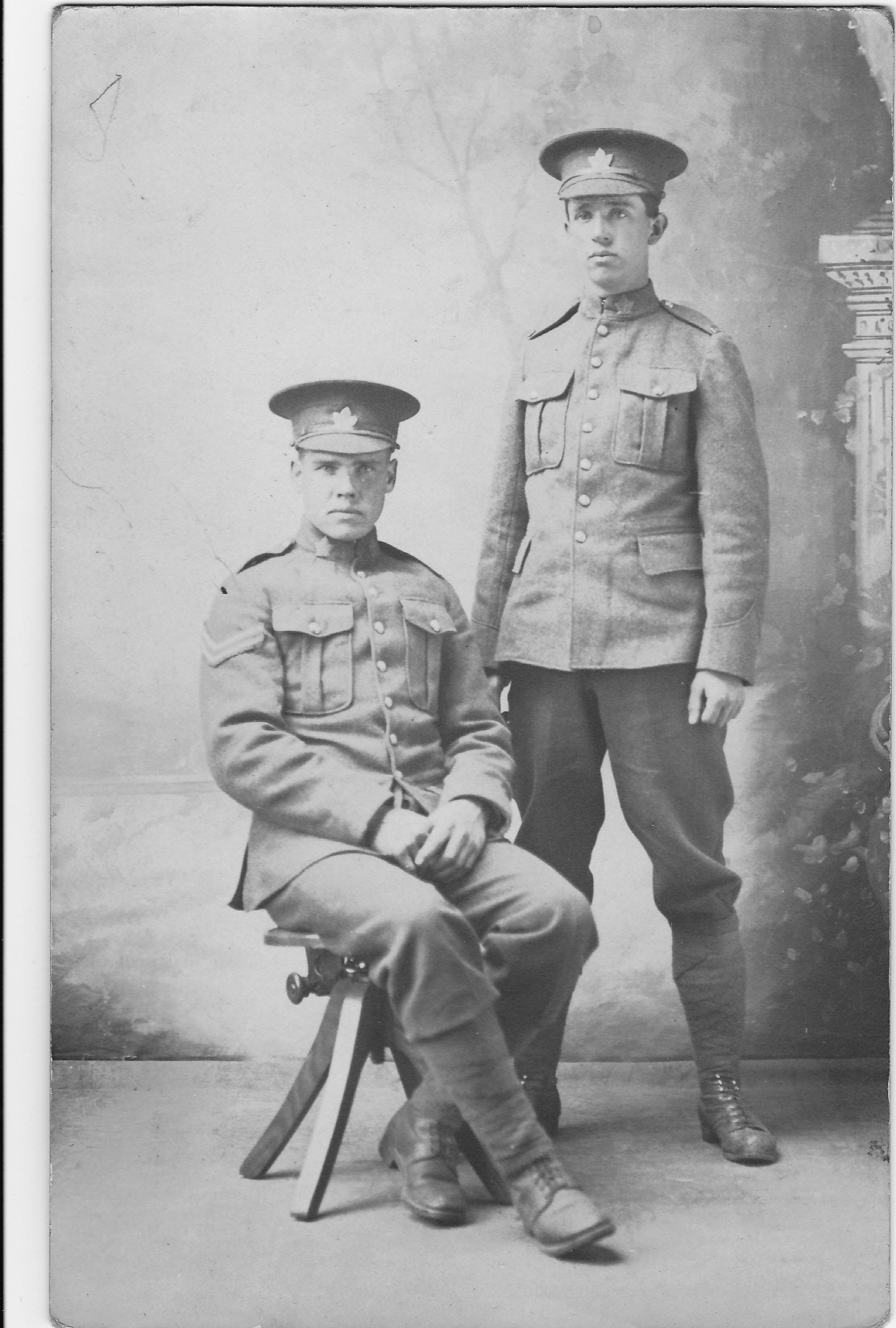Pte
William Robert Hodgan
Information about birth
|
Date of birth: 23/09/1897 |
|
Place of birth: Marquette, Michigan, United States of America |
General information
|
Last known residence: Billings, British Columbia, Canada |
|
Profession: Teamster |
|
Religion: Church of England |
Army information
|
Country: Canada |
|
Force: Canadian Expeditionary Force |
|
Rank: Private |
|
Service number: 931380 |
|
Enlistment date: 29/03/1916 |
|
Enlistment place: Grand Forks, British Columbia, Canada |
|
Units: — Canadian Infantry, 14th Bn. (Royal Montreal) (Last known unit) |
Information about death
|
Date of death: 04/11/1917 |
|
Place of death: Woodland Plantation, Passchendaele, Belgium |
|
Cause of death: Killed in action (K.I.A.) |
|
Age: 20 |
Memorial
|
Ypres (Menin Gate) Memorial Panel: Panel 24 |
Points of interest 4
| #1 | Place of birth | ||
| #2 | Last known residence | ||
| #3 | Enlistment place | ||
| #4 | Place of death (approximate) |
My story
William was born in 1897 in Marquette, Michigan, United States of America. The family moved to Canada, where William's father, Edward, worked for a large lumber company in Chase, British Columbia. When William enlisted in March 1916, he worked as a teamster in Billings, British Columbia on the Washington border. William joined the 14th Battalion (Royal Montreal).
In November 1917, the 14th Battalion was deployed at Passchendaele. Ever since 1915, the British high command had been toying with the idea of forcing a breakthrough in Flanders. But the Germans were prepared. A network of bunkers dominated the battlefield. After weeks of trudging through the mud, New Zealanders, Australians and South Africans joined the exhausted British divisions. Momentum was gained briefly, but then the attack stalled again. For the army high command, halting the offensive, however many lives that might save, was not an option. A victory, even a symbolic victory, was vital. Field Marshall Haig’s eye fell on Passchendaele. The heavily shelled village on top of the West Flemish ridge had been in German hands since 1914 and had assumed mythical proportions. To win that prize, Haig turned to the Canadians.
On 2 November 1917, William’s battalion relieved the 1st Canadian Mounted Rifles at Woodland Plantation, southwest of Passchendaele. During their stay on the front line, the 14th Battalion's positions were frequently shelled, with shrapnel and gas. Communication lines were also targeted, making it difficult to send reinforcements or evacuate wounded. Snipers were active on both sides. The battalion was relieved from the front line on the night of 4 November.
William was killed by German shellfire on 4 November 1917. He was buried near the lines. His remains were not identified and he is commemorated on the Menin Gate.
In November 1917, the 14th Battalion was deployed at Passchendaele. Ever since 1915, the British high command had been toying with the idea of forcing a breakthrough in Flanders. But the Germans were prepared. A network of bunkers dominated the battlefield. After weeks of trudging through the mud, New Zealanders, Australians and South Africans joined the exhausted British divisions. Momentum was gained briefly, but then the attack stalled again. For the army high command, halting the offensive, however many lives that might save, was not an option. A victory, even a symbolic victory, was vital. Field Marshall Haig’s eye fell on Passchendaele. The heavily shelled village on top of the West Flemish ridge had been in German hands since 1914 and had assumed mythical proportions. To win that prize, Haig turned to the Canadians.
On 2 November 1917, William’s battalion relieved the 1st Canadian Mounted Rifles at Woodland Plantation, southwest of Passchendaele. During their stay on the front line, the 14th Battalion's positions were frequently shelled, with shrapnel and gas. Communication lines were also targeted, making it difficult to send reinforcements or evacuate wounded. Snipers were active on both sides. The battalion was relieved from the front line on the night of 4 November.
William was killed by German shellfire on 4 November 1917. He was buried near the lines. His remains were not identified and he is commemorated on the Menin Gate.
Sources 7
|
Breanne Malo, Curator Chase & District Museum & Archives, personal communication, 15 January 2023. Sources used |
|
Census of Canada, 1911 ( Library and Archives Canada, Ottawa (LAC), RG31-C-1). https://library-archives.canada.ca/ Sources used |
|
Cook T., Shock Troops: Canadians fighting the Great War 1917-1918. Volume II (Toronto, Penguin Canada, 2008) 316-364. Sources used |
|
Personnel Records of the First World War (Library and Archives Canada, Ottawa (LAC) RG 150, Accession 1992-93/166, Box 4405 - 30). https://library-archives.canada.ca/ Sources used |
|
War diaries: 14th Canadian Infantry Battalion (Library and Archives Canada, Ottawa (LAC), RG9-III-D-3, Volume number: 4923, Microfilm reel number: T-10717, File number: 388). https://library-archives.canada.ca/ Sources used |
|
War Graves Registers: Circumstances of Death (Library and Archives Canada, Ottawa (LAC), RG 150, 1992-93/314; Volume Number: 192. https://library-archives.canada.ca/ Sources used |
|
War Graves Registry: Commonwealth War Graves (Library and Archives Canada, Ottawa (LAC): RG150, 1992-1993/314, Box 39-244; Box: 79). https://library-archives.canada.ca/ Sources used |
More information 4
|
Commonwealth War Graves Commission Database https://www.cwgc.org/find-records/find-war-dead/casualty-details/1593073 |
|
Namenlijst (In Flanders Fields Museum) https://namenlijst.org/publicsearch/#/person/_id=981d75e6-0e82-4df2-a5bf-a7cf374c4260 |
|
The Canadian Virtual War Memorial https://www.veterans.gc.ca/eng/remembrance/memorials/canadian-virtual-war-memorial/detail/1593073 |
|
Lives of the First World War (Imperial War Museum) https://livesofthefirstworldwar.iwm.org.uk/lifestory/5944048 |
